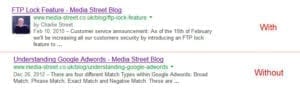 01392 914033
Offices are currently closed
01392 914033
Offices are currently closed
Have you been searching Google recently and seen photos in the search engine results? It’s called Google Authorship and today we’re going to discuss all about it and the benefits it brings. Not to mention discussing how to get it working on your website.

In one study a website owner noticed a 150% increase in click-through after implementing images into their search results. So from an SEO point of view it’s essential you implement Google Authorship today. Statistics like that aren’t worth ignoring.
Reasons to implement Google Authorship
To get started and to implement it on your website you’ll need to follow the steps outlined below.
To have you picture show in Google’s results you’ll need a Google+ account. If you’ve already got a Google account, great, you’re 50% done. If not, create one.
If you use Google Analytics, Google Adwords, Gmail or YouTube you should be able to use your current Google login for your Google+ account.
Now that you have your Google + account you’ll need to become a contributor and let Google know that you write content for websites.
Edit your contributor page and click Add Custom Link, then enter the website URL and click Save.
You must be a contributor for a website to have your picture show in the results. Link your Content with Google+ Now that you have an optimised Google+ account you want to link your website’s pages with Google. To do this you need to insert the following code.
[pastacode lang=”markup” message=”Demo Author Tag” highlight=”” provider=”manual”]
<a href=”[profile_url]?rel=author”>INSERT TEXT/IMAGE HERE</a>[/pastacode]
For example, I’d normally put something like this on a web page.
[pastacode lang=”php” message=”My Author Tag” highlight=”” provider=”manual”]
Author: <a href="https://plus.google.com/u/0/101605177347196280543?rel=author">Charlie Street</a>[/pastacode]
And there you have it; you can now add your image to Google’s search results. Just make sure, once you’re done, you test your mark-up by using Google’s Rich Snippets Testing Tool.
Yes. Originally it wasn’t possible but a recent update to Schema has made it so and it’s a lot easier then linking a page with your Google+ account. All you need is to enter the following code on your web pages.
[pastacode lang=”markup” message=”” highlight=”” provider=”manual”]
<div itemscope itemtype="http://schema.org/Organization">
<a itemprop="url" href="http://www.example.co.uk/">Home </a>
<img itemprop="logo" src="http://www.example.co.uk/logo.png" />
</div>[/pastacode]
Personally I’m more of a fan of showing your profile picture, compared to company logo. But either way one of them should be used on your website and sooner rather than later.
Eventually this trend will catch on and saturate the search engine results. For now a small percentage of website owners are doing it, but this percentage is growing every day. So the sooner you do it the greater the benefit. At present you should expect an increase in click-through rate of over 30+% but I can see it not being as effective next year, and even less the year after.